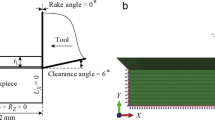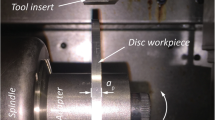Abstract
This study investigates the chip formation mechanism and relevant plastic flow stability in the orthogonal cutting process (OCP) through high-speed cutting experiments and theoretical modelling for four types of metals. The chip morphology transitions from continuous to serrated and to continuous again are observed with critical speeds depending on the work material properties and cutting conditions. To exam the influence of two-dimensional (2D) effects on plastic flow stability, a complete theoretical framework under plane strain state is established to model the 2D orthogonal cutting process. Based on the new framework, a set of governing equations with three dimensionless parameters are used to analytically derive a universal instability criterion, the approximate velocity fields, and stress fields in the expanding chip formation zone (CFZ). It is shown that the plastic flow of continuous chip may become unstable once the cutting speed reaches a critical value. In contrast to the shear localization deformation in the serrated chip, we found a new instability mechanism occurring in the continuous chip which undergoes the uniform but severe shear deformation due to the plane strain loadings. A new dimensionless parameter therefore is proposed to describe the plastic instability in continuous chip and the shear banding instability in serrated chip. The difference of two instability modes is further investigated in terms of dissipation mechanism of cutting energy, and the plastic instability of continuous chip is shown as the best instability mode regarding tool vibration and surface machining quality. These findings provide practical insights into improving modern cutting technology by controlling the plastic flow instability.













Similar content being viewed by others
References
Taylor FW (1906) On the art of cutting metals. Trans Am Soc Mech Eng XXVIII:31–350
Finnie I (1956) Review of the metal-cutting analysis of the past hundred years. Mech Eng 78:715–721
Shaw MC (1984) Metal cutting principles. Clarendon Press, Oxford
Arrazola PJ, Özel T, Umbrello D et al (2013) Recent advances in modelling of metal machining processes. CIRP Ann 62:695–718. https://doi.org/10.1016/J.CIRP.2013.05.006
Xu J, El Mansori M, Chen M, Ren F (2019) Orthogonal cutting mechanisms of CFRP/Ti6Al4V stacks. Int J Adv Manuf Technol. https://doi.org/10.1007/s00170-019-03734-x
Merchant ME (1945) Mechanics of the metal cutting process. I. Orthogonal cutting and a type 2 chip. J Appl Phys 16:267–275. https://doi.org/10.1063/1.1707586
Burns TJ, Davies MA (1997) Nonlinear Dynamics model for chip segmentation in machining. Phys Rev Lett 79:447–450. https://doi.org/10.1103/PhysRevLett.79.447
Burns TJ, Davies MA (2002) On repeated adiabatic shear band formation during high-speed machining. Int J Plast 18:487–506. https://doi.org/10.1016/S0749-6419(01)00006-7
Molinari A, Soldani X, Miguélez MH (2013) Adiabatic shear banding and scaling laws in chip formation with application to cutting of Ti–6Al–4V. J Mech Phys Solids 61:2331–2359. https://doi.org/10.1016/J.JMPS.2013.05.006
Li Z, Guo H, Li L et al (2019) Study on surface quality and tool life in ultrasonic vibration countersinking of titanium alloys (Ti6Al4V). Int J Adv Manuf Technol:1119–1137. https://doi.org/10.1007/s00170-019-03572-x
Schneider F, Bischof R, Kirsch B et al (2016) Investigation of chip formation and surface integrity when micro-cutting cp-titanium with ultra-fine grain cemented carbide. Proc CIRP 45:115–118. https://doi.org/10.1016/J.PROCIR.2016.02.257
Atkins AG (2003) Modelling metal cutting using modern ductile fracture mechanics: quantitative explanations for some longstanding problems. Int J Mech Sci 45:373–396. https://doi.org/10.1016/S0020-7403(03)00040-7
Liyao G, Minjie W, Chunzheng D (2013) On adiabatic shear localized fracture during serrated chip evolution in high speed machining of hardened AISI 1045 steel. Int J Mech Sci 75:288–298. https://doi.org/10.1016/J.IJMECSCI.2013.07.004
Luo XK, Cheng K, Luo XC, Liu XW (2005) A simulated investigation on the machining instability and dynamic surface generation. Int J Adv Manuf Technol 26:718–725. https://doi.org/10.1007/s00170-004-2057-z
Mahnama M, Movahhedy MR (2010) Prediction of machining chatter based on FEM simulation of chip formation under dynamic conditions. Int J Mach Tools Manuf 50:611–620. https://doi.org/10.1016/J.IJMACHTOOLS.2010.03.009
Moufki A, Devillez A, Segreti M, Dudzinski D (2006) A semi-analytical model of non-linear vibrations in orthogonal cutting and experimental validation. Int J Mach Tools Manuf 46:436–449. https://doi.org/10.1016/J.IJMACHTOOLS.2005.04.017
Ye GG, Xue SF, Ma W et al (2012) Cutting AISI 1045 steel at very high speeds. Int J Mach Tools Manuf 56:1–9. https://doi.org/10.1016/J.IJMACHTOOLS.2011.12.009
Wan L, Wang D, Gao Y (2016) The investigation of mechanism of serrated chip formation under different cutting speeds. Int J Adv Manuf Technol 82:951–959. https://doi.org/10.1007/s00170-015-7409-3
Ma W, Chen X, Shuang F (2017) The chip-flow behaviors and formation mechanisms in the orthogonal cutting process of Ti6Al4V alloy. J Mech Phys Solids. https://doi.org/10.1016/j.jmps.2016.07.023
Wagner V, Baili M, Dessein G (2014) The relationship between the cutting speed, tool wear, and chip formation during Ti-5553 dry cutting. Int J Adv Manuf Technol 76:893–912. https://doi.org/10.1007/s00170-014-6326-1
Piispanen V (1948) Theory of formation of metal chips. J Appl Phys 19:876–881. https://doi.org/10.1063/1.1697893
Palmer WB, Oxley PLB (1959) Mechanics of metal cutting. Proc Inst Mech Eng 173:623–645
Oxley PLB, Welsh MJM (1963) Calculating the shear angle in orthogonal metal cutting from fundamental stress, strain-rate properties of the work material. In: Proceedings 4th International Machine Tool Design and Research Conference. Pergamon, Oxford
Ma W, Li X, Dai L, Ling Z (2012) Instability criterion of materials in combined stress states and its application to orthogonal cutting process. Int J Plast 30–31:18–40. https://doi.org/10.1016/J.IJPLAS.2011.09.003
Luo J, Li M, Li X, Shi Y (2010) Constitutive model for high temperature deformation of titanium alloys using internal state variables. Mech Mater 42:157–165. https://doi.org/10.1016/J.MECHMAT.2009.10.004
G.T. Gray III, S.R. Chen, W. Wright, M.F. Lopez (1994) Constitutive equations for annealed metals under compression at high strain rates and high temperatures. Los Alamos National Laboratory. LA-12669-MS. UC-000, Issued: January
Liu Y, Cai S, Shang X, Dai L (2017) Suppression of Hopf bifurcation in metal cutting by extrusion machining. Nonlinear Dyn 88:433–453. https://doi.org/10.1007/s11071-016-3251-x
Johnson GR, Cook WH (1985) Fracture characteristics of three metals subjected to various strains, strain rates, temperatures and pressures. Eng Fract Mech 21:31–48. https://doi.org/10.1016/0013-7944(85)90052-9
Hortig C, Svendsen B (2007) Simulation of chip formation during high-speed cutting. J Mater Process Technol 186:66–76. https://doi.org/10.1016/J.JMATPROTEC.2006.12.018
Shuang F, Chen X, Ma W (2018) Numerical analysis of chip formation mechanisms in orthogonal cutting of Ti6Al4V alloy based on a CEL model. Int J Mater Form. https://doi.org/10.1007/s12289-017-1341-z
Fang N (2003) Slip-line modeling of machining with a rounded-edge tool—Part I: new model and theory. J Mech Phys Solids 51:715–742. https://doi.org/10.1016/S0022-5096(02)00060-1
Bisacre FFP, Bisacre GH (1947) The life of carbide-tipped turning tools. Proc Inst Mech Eng 157:452–469. https://doi.org/10.1243/PIME_PROC_1947_157_070_02
Gioia G, Ortiz M (1996) The two-dimensional structure of dynamic boundary layers and shear bands in thermoviscoplastic solids. J Mech Phys Solids 44:251–292. https://doi.org/10.1016/0022-5096(95)00071-2
Bai YL (1982) Thermo-plastic instability in simple shear. J Mech Phys Solids 30:195–207. https://doi.org/10.1016/0022-5096(82)90029-1
Molinari A (1997) Collective behavior and spacing of adiabatic shear bands. J Mech Phys Solids 45:1551–1575. https://doi.org/10.1016/S0022-5096(97)00012-4
Hill R (1950) The mathematical theory of plasticity. Oxford Univ. Press, Oxford
Funding
This work was supported by the National Nature Science Foundation of China (Grant numbers: 11572337, 11772346, and 51575029).
Author information
Authors and Affiliations
Corresponding author
Additional information
Publisher’s note
Springer Nature remains neutral with regard to jurisdictional claims in published maps and institutional affiliations.
Rights and permissions
About this article
Cite this article
Ma, W., Shuang, F. The plastic flow stability of chip materials in metal cutting process. Int J Adv Manuf Technol 105, 1933–1948 (2019). https://doi.org/10.1007/s00170-019-04353-2
Received:
Accepted:
Published:
Issue Date:
DOI: https://doi.org/10.1007/s00170-019-04353-2




